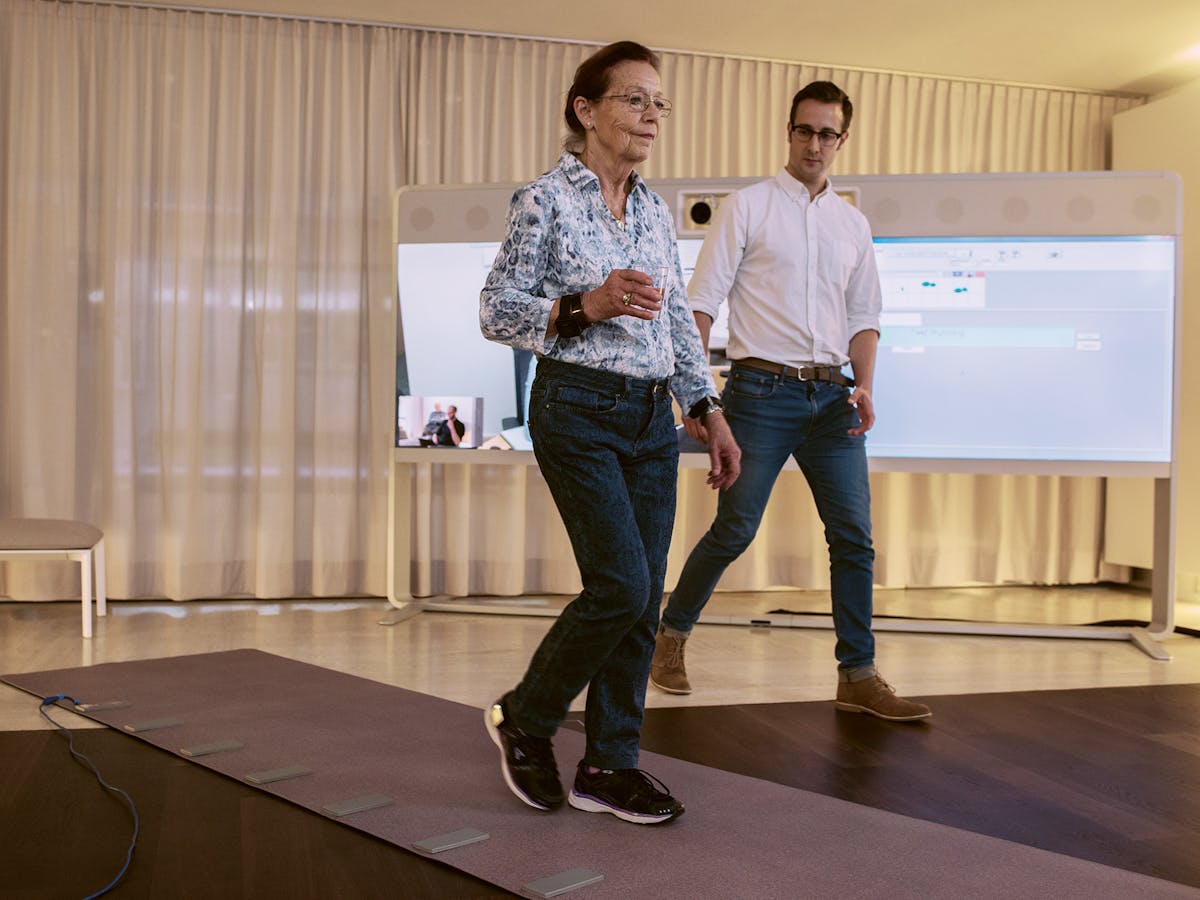
Computers can detect what may be impossible for the human eye to see.
“A physician can tell a huge amount from how a person walks,” says Ronenn Roubenoff, Global Head of Musculoskeletal Disease Translational Medicine at the Novartis Institutes for BioMedical Research. “Many physicians, and geriatricians in particular, consider gait speed as a ‘fifth vital sign’ of health.”
How a person walks gives clues about endurance, musculoskeletal functioning, pain, balance, and even cognitive symptoms. Walking tests are remarkably accurate predictive tools and trouble walking is associated with higher risks of falling, hospitalization, cognitive decline, and death.
In an era of ubiquitous Fitbits, Garmins, and Apple watches, technology is primed to transform the traditional walking tests of the past into far more informative, and convenient, medical tools.
Novartis is collaborating with researchers throughout Europe and elsewhere to ensure that these innovations are regulated and clinically validated – both as methods to develop new mobility-targeted treatments and, potentially, as treatments themselves.
Commitment to mobility
“The global population is living longer and loss of mobility is one of the major contributors to people’s loss of independence as they age,” explains Roubenoff. “Chronic diseases and injuries also cause loss of mobility and this has a huge impact on a person’s quality of life – people really care about getting out of their houses and living their lives.”
The Novartis Musculoskeletal Disease (MSD) group has a long-standing focus on developing pharmaceutical solutions that keep people moving, and mobility also plays a role in many of the diseases that Novartis aims to treat. As digital mobility sensors offer unprecedented insights into precisely how treatments affect patients’ physical abilities, teams across disease areas are looking to integrate clinically validated mobility devices into the R&D and clinical trials for new treatments.
“Mobility is relevant to nearly every organ system in the body – for example chronic obstructive pulmonary disease, heart failure, cancer, and osteoarthritis all affect mobility, and physical activity in turn affects the symptoms of these conditions,” declares Roubenoff. “With digital technologies, we can now measure mobility in much greater detail, allowing us to better address a fundamental facet of the patient experience that we simply haven’t been able to capture well in the past.”
Making steps count
“In contrast to the consumer devices that so many people have now, we’re developing digital devices that monitor not only how much patients are moving, but how well they’re moving – how fast, if they’re stumbling or falling, and what they’re actually doing in their real environments,” explains Roubenoff.
Compared to physicians’ traditional walking tests – typically anywhere from a few steps to walking for six minutes – digital monitoring is also providing a far more comprehensive and objective picture of how people move about in their daily activities, all without patients needing to go to the clinic.
“Machine learning and analytics are making it possible to take advantage of huge amounts of data that we’re now just dipping into,” says Roubenoff.
Endpoints with impact
Before any of these methods and treatments begin appearing at the doctor’s office, first they must go through the same regulatory hurdles that every other drug and intervention have to pass. The industry must standardize, regulate, and prove the benefit of these innovations to doctors, patients, health authorities and health insurers.
“If a device tells you that you’re taking more steps, or that your gait has improved, how do we prove that helps a patient feel better, function better, or live longer?” says Roubenoff. “Regulators want us to show that these digital measurements are actually connected to medically relevant outcomes, so the development of new endpoints and the development of new drugs go hand in hand.”
This critical task has brought together researchers from across not only the pharmaceutical industry, but also medical and academic institutions around Europe. In partnership with Newcastle University in the UK, Novartis has co-led the creation of the Mobilise-D project, which will design and validate algorithms for digitally measuring mobility. Earlier this year, Mobilise-D won 50 million euros in funding from the European Innovative Medicines Initiative (IMI) 2 Joint Undertaking.The Group funds public-private collaborations that address unmet medical needs which are difficult for either side to undertake alone.
Moving together
“Our first objective is to create a way of measuring steps accurately that does not depend on what medical device someone is using,” declares Roubenoff, who is also the industry project lead for Mobilise-D. “Once this is accomplished, the second step will be to show that these mobility endpoints are linked to health outcomes.”
The Mobilise-D consortium includes a total of 34 universities, clinical centers, and pharmaceutical and technology companies. The participating clinical centers already have ongoing studies for conditions such as chronic obstructive pulmonary disease, hip fracture recovery, Parkinson’s disease, multiple sclerosis, and congestive heart failure. The project’s second aim will be combined with these established studies.
“As a publically funded project, the resulting tools will be publically available and manufacturers around the world will be able to use the algorithms to develop their own devices and to get them validated more easily,” says Roubenoff. “We want these algorithms to become the new standard that the US Food and Drug Administration and the European Medicines Agency recognize as valid endpoints for clinical trials, and we hope that these new endpoints will apply to medicines across any disease in which mobility is relevant.”







